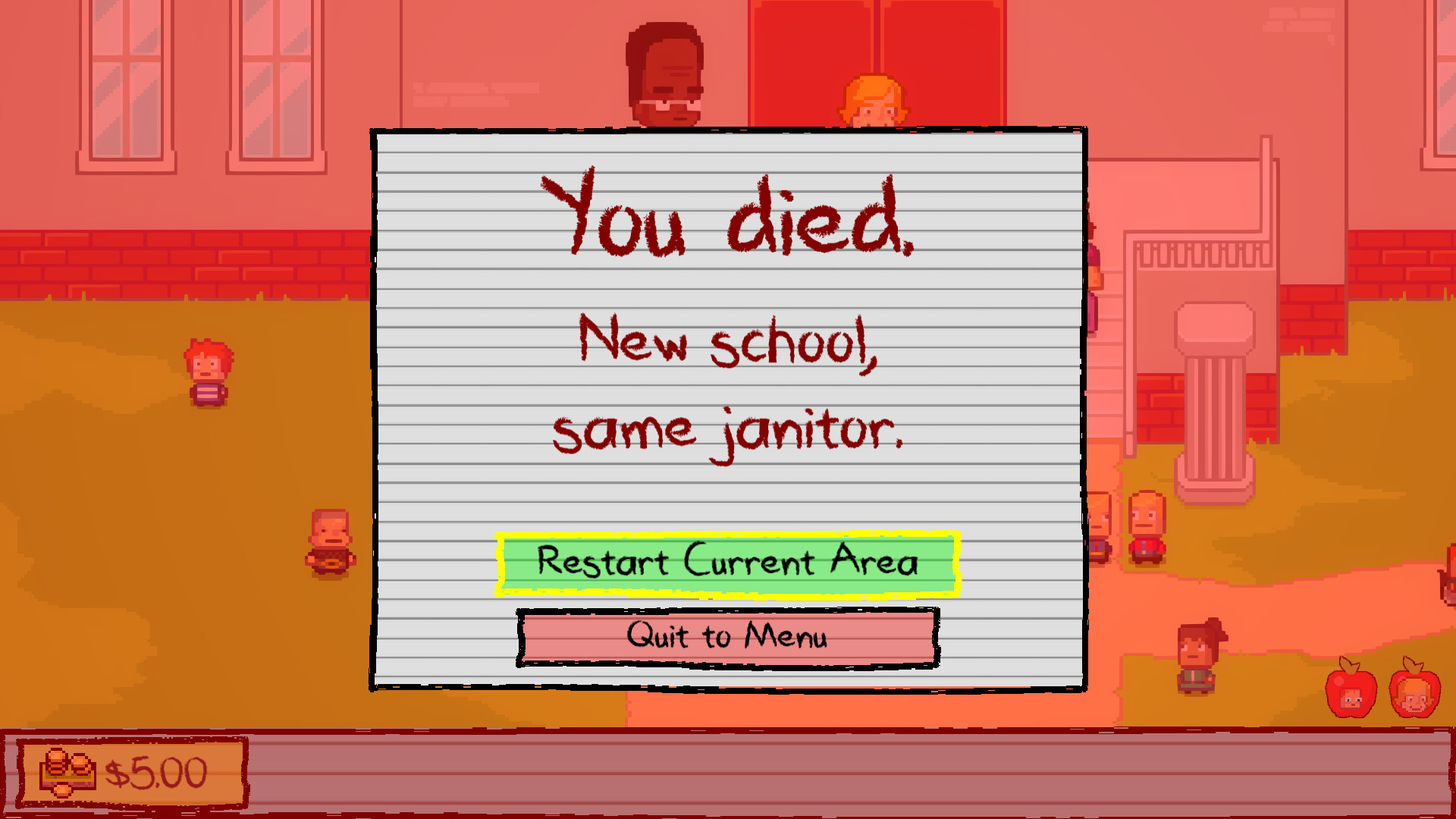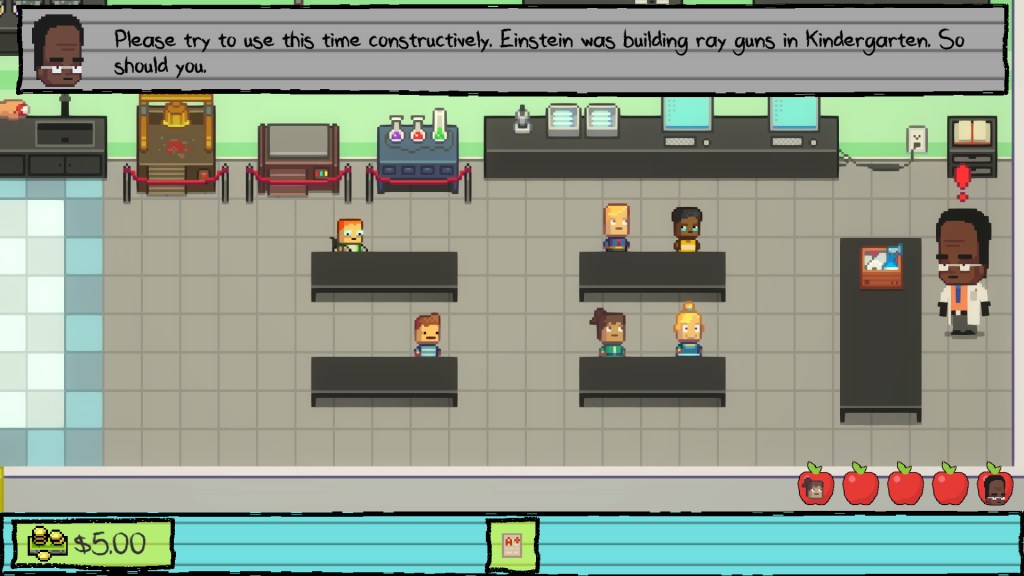
When Kindergarten came out in 2017, it struck me by surprise. A small, unknown game turned out to be one of the smartest realizations of groundhog day concept in video games I’ve seen. In combination with a twisted sense of humor and witty writing, turned it into one of my year’s highlights. Obviously, when I’ve heard about the release of a sequel, I cleared my schedule specifically to play it. In retrospect, it wasn’t the smartest decision.
The Basics

So, what is Kindergarten all about? It puts you into the shoes of a kid in a seemingly inconspicuous school. The first day is fairly bland as you get to meet everyone and hear what they have to say. As the day ends, for some inexplicable reason, you are pulled back in time to start it all over again. Now, however, you are armed with information that pushes you closer towards discovery of school’s dark secrets.
Each iteration of the loop is split between traditional school activities: lessons, lunch, recess, etc. Instead of operating on the clock, however, the length of each section is governed by apples. Apples are a resource, where a single piece of fruit corresponds to one important action. Running out of apples means getting booted to the next zone, so you have to be smart with them. Every action has to be a step towards befriending a specific target by completing their questline. How do you know what their questline is? Well, by speaking to them and to others in the school.

It is that gameplay loop of getting new information and putting it to use that made me so enthralled with the game. While game did mark down important hints for you, they were obscure enough to make you do some legwork. Through trial and error (and occasional hilarious death scenes) you might have just ended the day with getting an absolute trust of another kid or a teacher. As a parting gift, they bestowed you with an item that opened up a new questline…and so on, and so forth, until you were equipped to tackle the ultimate mystery.
This core principle worked specifically because Kindergarten dared to be obscure. Once you figured out what items belonged to what questlines, it was simply a question of proper sequencing, as narrowing down of options left little room for second-guessing. Each completed quest line made others more trivial and by the end, I was just clicking through obvious choices to see the ending.
There was not much time for that realization of the game’s flaws to fester, however, as it was quite short. The game did not overstay its welcome as full playthrough takes about 5 to 6 hours. For a price of 5 dollars, Kindergarten gave me enough joy to make me yearn for more. Kindergarten 2, meanwhile, is a bit pricier. With a new price tag, I assumed that game packs more content and improvements over the ideas of the original to justify it. How right was my assumption? Well…
What went wrong
You may wonder why I took so much time talking about Kindergarten if this is supposed to be a review of a sequel. Simply put, they are the same game. Only sequel is somehow a little bit worse. While the main gameplay mechanics remain the same, Kindergarten 2 mistakenly assumes that its main strength is in immaculate writing and chooses to remove any hurdles that could have stopped you from enjoying it. Specifically, it streamlines the way you get the info. If debut required you to do some guesswork to figure out how to start a questline, Kindergarten 2 “kindly” offers you a story map which explicitly tells you what to do: which items to bring, who to talk to and even in what order you should talk to several people. To simplify things even more, NPCs now tell you exactly what they want instead of veiling it with some flowery language.

What it causes is that sequel completely strips a requirement to pay close attention to dialogue, as after you have started the quest, there is only obvious course of action you can take. At times, I have found myself just skipping through dialogue as the game made it far too obvious what option is proper. Still, I hoped that story would somehow expand on bizzare Kindergarten universe and make sense of creepy things that are happening in it…except it did not.
I’m going to drop some mild story spoilers here, so tread carefully if you want to play the game in the future. The story beats of the first game are as follows: before the game begins, a student suddenly vanishes without a trace. This makes children at school suspicious of its administration and soon you uncover that principle is the culprit. After discovering some underground mutants, he kidnaps one student to conduct experiments on him. At the same time, he is keeping everyone in check by distributing pills which are made from the said mutants. In the final act of the game, the player confronts principal, the player wins and frees kidnapped student.
Well, what happens in Kindergarten 2? It is a direct continuation of the first game as all children are transferred to a new school…where exactly the same things happen. Some children get kidnapped, principle is guilty, and the final act of the game is mirrored. You fight principle in their underground laboratory, you win, you free some children. Even the quest revolving around one particularly bizarre child – Nugget – is recycled to the point of erasing the continuity.
Extracurricular activities

There are few new things which game adds. The original collectible – Monstermon cards – have a new purpose: you can use them to play a game (think Hearthstone or MTG) with other kids on recess. The secret ending, which you get by gathering all Monstermon cards, returns as well but, as you might have guessed, it is more of the same.
The new addition are outfits that you can mix and match. Those you unlock by finding them throughout the school in particular places and periods of time. It would have been fun to hunt for them (as well as Monstermon cards) if the game did not just outright told you how to get its “hidden” collectibles. After you finish the main questline, game gives you a map which tells you where you can find all collectibles which kinda defeats the whole point of them.
Final Thoughts

I do not want to slander the developers and say that they intended this game to be a cash grab, coat tailing on the surprising success of the original. I will say, however, that they might have misinterpreted what made the first game so special. It was the joy of exploration, of blindly discovering the game’s premise that made you stick around in the first game. This time, the game just serves everything that is has to offer on a silver platter, falsely assuming that Kindergarten 2 can stand on its own without a veil of mystery. Still, if you just want more of the same, Kindergarten 2 kinda serves its purpose. It is not a bad game on its own, I just expected more from it after two years of waiting.
Final Score: Meh

Hmm, this has at least gotten me intrigued with the first Kindergarten game. Good post. 🙂
LikeLiked by 1 person
Kindergarten 1 is definitely an experience worth checking out. It’s short, cheap, and sweet and also has some really hearty laughs packed in. Cannot recommend it enough!
LikeLike
Valuable information. Lucky me I discovered your
site by chance, and I am surprised why this accident did not came
about in advance! I bookmarked it.
LikeLiked by 1 person
Thank you for liking what we’ve been doing so far! 🙂 Stay tuned for more reviews and upcoming PAX coverage by Angie!
LikeLike
Aw, man. I mean- it makes sense but given how much I’ve enjoyed the first one, I’ll have to see on the second. You pretty much nailed it on the head involving what was special about the first one. Glad to hear a grounded constructive view on it, though!
LikeLiked by 1 person
Well, if you really liked Kindergarten 2 universe, I think that it is still worth checking out just for that, but I’d probably wait for some kind of sale because I don’t think the current price tag is justified.
LikeLiked by 1 person